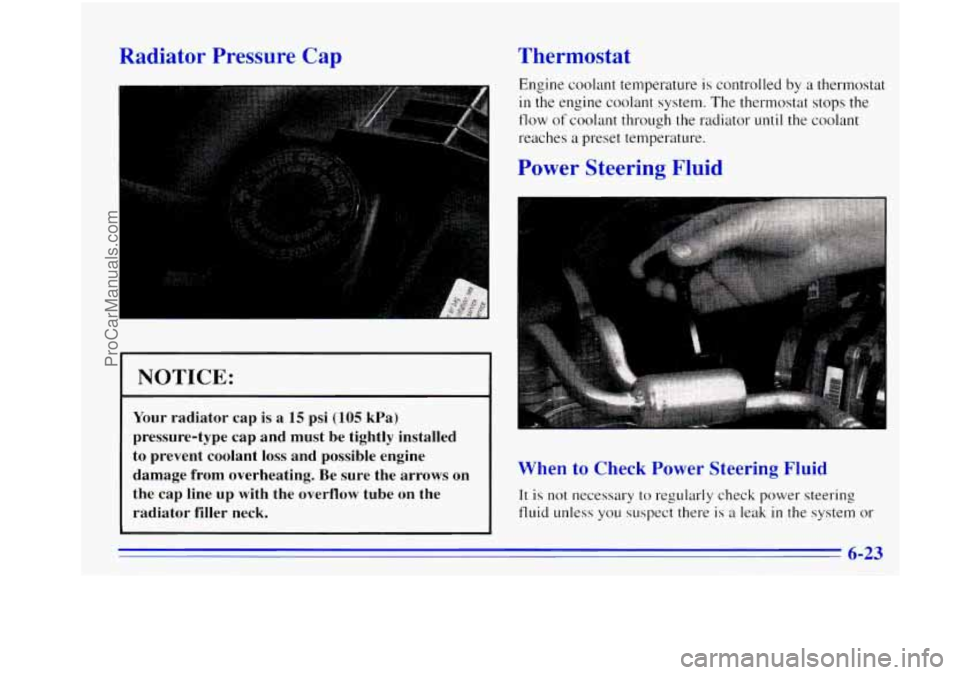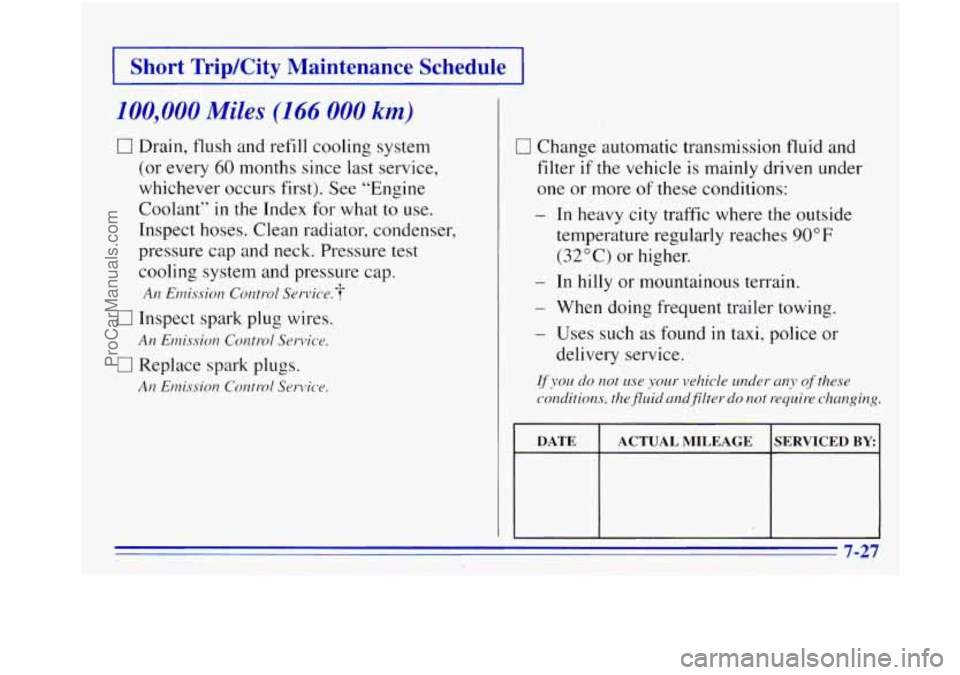coolant temperature OLDSMOBILE BRAVADA 1996 Owners Manual
[x] Cancel search | Manufacturer: OLDSMOBILE, Model Year: 1996, Model line: BRAVADA, Model: OLDSMOBILE BRAVADA 1996Pages: 340, PDF Size: 17.49 MB
Page 65 of 340

Engine Coolant Heater (Option)
The engine coolant heater
cord is secured on the
driver’s side of the vehicle,
by the brake controller.
In very cold weather,
0°F (- 18OC) or colder, the engine
coolant heater can help. You’ll get easier starting and
better fuel economy during engine warm-up. Usually,
the coolant heater should be plugged in
a minimum of
four hours prior to starting your vehicle.
To use the coolant heater:
1. Turn off the engine.
2. Open the hood and unwrap the electrical cord.
3. Plug it into a normal, grounded 110-volt AC outlet.
~ Plugging the cord into an ungrounded outlet
~ could cause an electrical shock. Also, the wrong
1 kind of extension cord could overheat and cause
~ a fire. You could be seriously injured. Plug the
~ cord into a properly grounded three-prong
110-volt AC outlet.
If the cord won’t reach, use a
heavy-duty three-prong extension cord rated for
at least 15 amps.
4. After you’ve used the coolant heater, be sure to store
the cord as it was before
to keep it away from moving
engine parts.
If you don’t, it could be damaged.
How long should you keep the coolant heater plugged
in? The answer depends on the outside temperature, the
kind
of oil you have, and some other things. Instead of
trying to list everything here, we ask that you contact
your Oldsmobile retailer in the area where you’ll be
parking your vehicle. The retailer can give you the best
advice for that particular area.
ProCarManuals.com
Page 106 of 340

Anti-Lock Brake System Warning Light
With the anti-lock brake
system, this light will come
on when you start your
engine and may stay on
for several seconds.
That‘s normal.
Engine Coolant Temperature Gage
This gage shows the engine
coolant temperature.
If the
gage pointer moves into the
red area, your engine is
too hot!
If the light stays on, or comes on when you’re driving,
your Oldsmobile needs service. If the regular brake
system warning light isn’t
on, you still have brakes, but
you don’t have anti-lock brakes.
If the regular brake
system warning light is also on, you don’t have anti-lock
brakes and there’s a problem with your regular brakes.
See “Brake System Warning Light” earlier in this part.
The anti-lock brake system warning light should come
on briefly when you turn
the ignition key to RUN. If the
light doesn’t come on then, have
it fixed so it will be
ready
to warn you if there is a problem. It
means that your engine coolant has overheated.
Tf you
have been operating your vehicle under normal driving
conditions, you should pull off the road, stop your
vehicle and turn off the engine
as soon as possible.
In “Problems on the Road,”
this manual shows you what
to do. See “Engine Overheating” in the Index.
ProCarManuals.com
Page 111 of 340

Daytime Running Lamps Indicator Light
:::o 0.0
You may have this light on
the instrument panel.
It goes on whenever the
DRL are on, the ignition is
on, the headlamp switch is
off and the parking brake
is released.
Check Gages Light
CHECK
GAGES
The CHECK GAGES light
will come on briefly when
you are starting the engine.
If the light comes on and
stays on while you are
driving, check your coolant
temperature and engine oil
pressure gages
to see if they
are in the warning zones.
ProCarManuals.com
Page 115 of 340

Air Conditioning Heating
On hot
days, open the windows long enough to let hot
inside air escape. This reduces the time it takes for your
vehicle to cool down. Then keep your windows closed
for the air conditioner to work its best.
For quick cool-down
on very hot days, use MAX A/C
with the temperature knob turned counterclockwise.
This setting should be used to keep odors and/or dust
from entering the vehicle. For normal cooling on hot
days, use A/C with the temperature knob turned
counterclockwise.
On cool but sunny days, use
BI-LEVEL A/C to deliver
warm air to the floor and cooler air to the instrument
panel outlets.
When the air conditioner is on, you may sometimes
notice slight changes in your vehicle’s engine speed
and power.
This is normal because the system is
designed to cycle the compressor on and off to keep
the desired temperature. The
heater works best if you keep your windows closed
while using it. On cold days, use HEATER with the
temperature knob turned clockwise.
BLEND is useful in
cool weather when you have fog or ice on the
windshield or side windows.
If you use the optional engine coolant heater before
starting your engine, your heating system will produce
warmer air faster to heat the passenger compartment in
cold weather. See “Engine Coolant Heater” in the Index.
Ventilation System
For mild outside temperatures when little heating or
cooling is needed, use VENT to direct outside air
through your vehicle. Airflow is through the instrument
panel outlets.
Your vehicle’s ventilation system supplies outside air to
the inside
of your vehicle when it is moving. When the
vehicle is not moving, you can get outside air to flow
through by selecting any mode and any fan speed.
3-3
ProCarManuals.com
Page 191 of 340

Engine Overheating
You will find a coolant temperature gage on your
vehicle’s instrument panel.
If Steam Is Coming From Your Engine
Steam from an overheated engine can burn you
badly, even if you just open the hood. Stay away
from the engine
if you see or hear steam coming
from it. Just turn it off and get everyone
away
from the vehicle until it cools down. Wait until
there is no sign of steam or coolant before
opening the hood.
If you keep driving when your engine is
overheated, the liquids in it can catch fire. You or
others could be badly burned. Stop your engine if
it overheats, and get out of the vehicle until the
engine is cool.
I NOTICE:
If your engine catches fire because you keep
driving with no coolant, your vehicle can be
badly damaged. The costly repairs would not be
covered by your warranty.
3-11
ProCarManuals.com
Page 231 of 340

Rear Axle What to Use
When to Check and Change Lubricant
Refer to the Maintenance Schedule to determine how
often to check the lubricant and when to change it. See
“Scheduled Maintenance Services”
in the Index.
How to Check Lubricant
If the level is below the bottom of the filler plug hole,
you’ll need to add some lubricant. Add enough lubricant
to raise the level
to the bottom of the filler plug hole. Refer to the Maintenance
Schedule to determine what
kind of lubricant to use. See “Recommended Fluids and
Lubricants”
in the Index.
Engine Coolant
The cooling system in your vehicle is filled with new
DEX-COOL TM (orange-colored, silicate-free) engine
coolant. This coolant
is designed to remain in your
vehicle for
S years or 100,000 miles (1 66 000 km),
whichever occurs first.
The following explains your cooling system and
how to
add coolant when it is low. If you have a problem with
engine overheating, see “Engine Overheating”
in
the Index.
A SO/SO mixture of water and the proper coolant for
your Oldsmobile
will:
0 Give freezing protection down to -34°F (-37°C).
0 Give boiling protection up to 265°F (129°C).
0 Protect against rust and corrosion.
Help keep the proper engine temperature.
Let the warning lights and gages work as
they should.
ProCarManuals.com
Page 235 of 340

Radiator Pressure Cap
I
NOTICE:
Your radiator cap is a 15 psi (105 kPa)
pressure-type cap and must be tightly installed
to prevent coolant loss and possible engine
damage from overheating. Be sure the arrows on
the cap line up with the overflow tube on the
radiator filler neck.
Thermostat
Engine coolant temperature is controlled by a thermostat
in the engine coolant system. The thermostat stops the
flow of coolant through the radiator
until the coolant
reaches a preset temperature.
Power Steering Fluid
When to Check Power Steering Fluid
It is not necessary to regularly check power steering
fluid unless you suspect there is a leak in the system or
6-23
ProCarManuals.com
Page 297 of 340

I Short TripKity Maintenance Schedule I
100,000 Miles (144 000 km)
Cl Drain, flush and refill cooling system
(or every
60 months since last service,
whichever occurs first). See “Engine
Coolant” in the Index for what to use.
Inspect hoses. Clean radiator, condenser,
pressure cap and neck. Pressure test
cooling system and pressure cap.
An Emission Control Service.?
0 Inspect spark plug wires.
0 Replace spark plugs.
An Emission Control Service.
An Emission Control Service.
17 Change automatic transmission fluid and
filter
if the vehicle is mainly driven under
one or more of these conditions:
- In heavy city traffic where the outside
temperature regularly reac hes
90 O F
(32°C) or higher.
- In hilly or mountainous terrain.
- When doing frequent trailer towing.
- Uses such as found in taxi, police or
delivery service.
If you do not use your vehicle under uny of tlzese
conditions, the jluid
andji‘ltev do not require changing.
DATE ACTUAL MILEAGE SERVICED BY
7-27
ProCarManuals.com